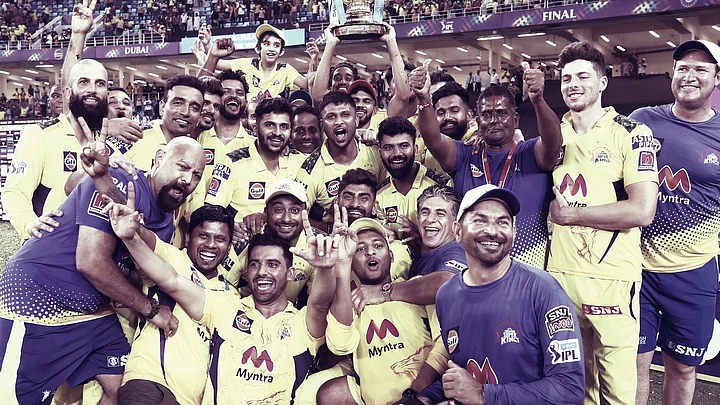In 2008, Lalit Modi's announcement on launching the IPL triggered disbelieving smirks, widespread scepticism, and sharp criticism. Traditionalists disapproved of the showy tournament that reduced cricket to a crude Bollywood item number with dancing cheerleaders and leering spectators.
That was then.
Today, the doubts have disappeared and the IPL is both a cricket and commercial blockbuster. In monetary terms, the BCCI is expecting television rights sales to fetch Rs 1,000 crore a year, going forward.
The IPL took off like a rocket, and thanks to COVID-19, discarded the peripherals it never needed. Noise has subsided and the notorious after-match parties are gone. Cheerleaders still go through their routine but theirs is a tired performance, an item number that has lost its sizzle.
The IPL has undergone rehab to get healthy. Team owners have receded to the background to take a dignified backseat. SRK continues to wave imperiously from his box at Eden Gardens, but the IPL is about players and brands, fan loyalty, and engagement.
The IPL Makes India Cricket's Vishwaguru
The IPL is Indian cricket's great export that changed the power dynamics of the global sport. Because of the IPL, India is an entrepreneur, not a customer, and a world leader. The IPL is India's sole creative contribution to world cricket since Ranji invented the leg glance one hundred years ago.
IPL Is Cricket's Green Revolution
The IPL did to cricket what the Green Revolution did to Indian agriculture, and what liberalisation did to the Indian economy. It changed the system by 'auctioning' players and determining wages through the interplay of market forces. Players got paid according to merit, not on a fixed scale decided by the BCCI, and this injection of cash made the IPL the fast track to fame and riches.
Market-driven salaries reduced the dependence of domestic players on lowly government jobs and temporary PSU contracts. Fortunately, the BCCI designed the IPL as a 'domestic tournament' and granted job reservations – Indians in the playing eleven rule. This ensures that the demand for Indian talent remains high.
Result: IPL's cash revolution created cricket crorepatis.
The IPL Is Atmanirbhar Cricket That Respects Fans
The 2020 season added a new twist to the IPL's commercial surge with a Fantasy Sports platform becoming its lead sponsor. This was the first instance of a cricket corporate, an insider, stepping up to support the tournament instead of an outside entity, such as a real estate player, a cola, or a mobile handset manufacturer.
This demonstrates the rising influence of the fan and the economic opportunities that it throws up. Earlier, the fan was used for buying tickets and merchandise; now, the evolved fan (with knowledge, smartphone, cheap data, and good connectivity) is an active participant, not a passive consumer of cricket.
IPL Changed the Player and Indian Cricket
Aware of the IPL's life-changing opportunities, players work on fitness and develop multiple skills needed for the 20-over format. This is accompanied by an aspirational shift where the IPL is the end goal, the final destination, replacing the traditional career pathway of Ranji-Duleep-India.
The IPL throws up new confident players who are ready to take on the best. The IPL created 'white ball' specialists like Shahrukh Khan who command multiple crores in the player auction.
As India discovered its separate set of 'Red and White' cricketers, one can't escape the irony of Lalit Modi's contribution to making this happen. Interestingly, he owned Godfrey Philips India, the makers of the popular Red and White cigarettes.
The IPL fast-tracked players into the Indian team by opening a new highway that avoided traffic and helped them jump the queue ahead of those waiting longer. Because of the IPL, Ranji bowling attacks revolve around quicks and a leggie or a left-arm spinner, and the fielding standards are up, as is the run rate. Ranji games produce more outright results because teams chase wins and, inspired by Virat Kohli, Ben Stokes is remembered fondly on the domestic circuit.
IPL Relaxes Control, Introduces 'Cricket Azaadi'
It wasn't the intention but the IPL became cricket's moment of azaadi, the tipping point of internal freedom from control and restrictions. Just as India's liberalisation unshackled an economy chained by regulation and control, the IPL freed up cricket and unlocked fresh energy.
For players, IPL is cricket's 'bypass stent' that eases a career stifling blockage and introduces a new route to the top. Players no longer have to slave for years in domestic cricket to get rewarded – instead, they can paradrop to the top (like sons of film stars and politicians) by taking the IPL shortcut. This 'opening' is as significant as discovering a new route to Everest or granting a bright student a double promotion in class.
Talented players without Ranji experience get noticed in state leagues by IPL 'spotters' and find themselves sharing a dressing room with Thala MSD and King Kohli.
This is possible because the IPL made BCCI selectors redundant and removed them from the equation. Ajay Jadeja explains this best: Earlier, players were desperate to please 5 selectors who controlled the careers of 1,000 first-class players. But the IPL appointed hundreds of spotters who search for talent and break BCCI's monopoly over selection. Jadeja astutely points out that the IPL has moved cricket from consistency (needed in Ranji and Tests) to intent and impact, from solid defense to tactical aggression.
Players, liberated in spirit, don't have to attend formal coaching in cricket academies anymore; they instead receive online education by watching the IPL. With Brain Lara and other experts breaking down the finer points and performing live demos from a television studio dugout, priceless cricket gyaan is available for free.
